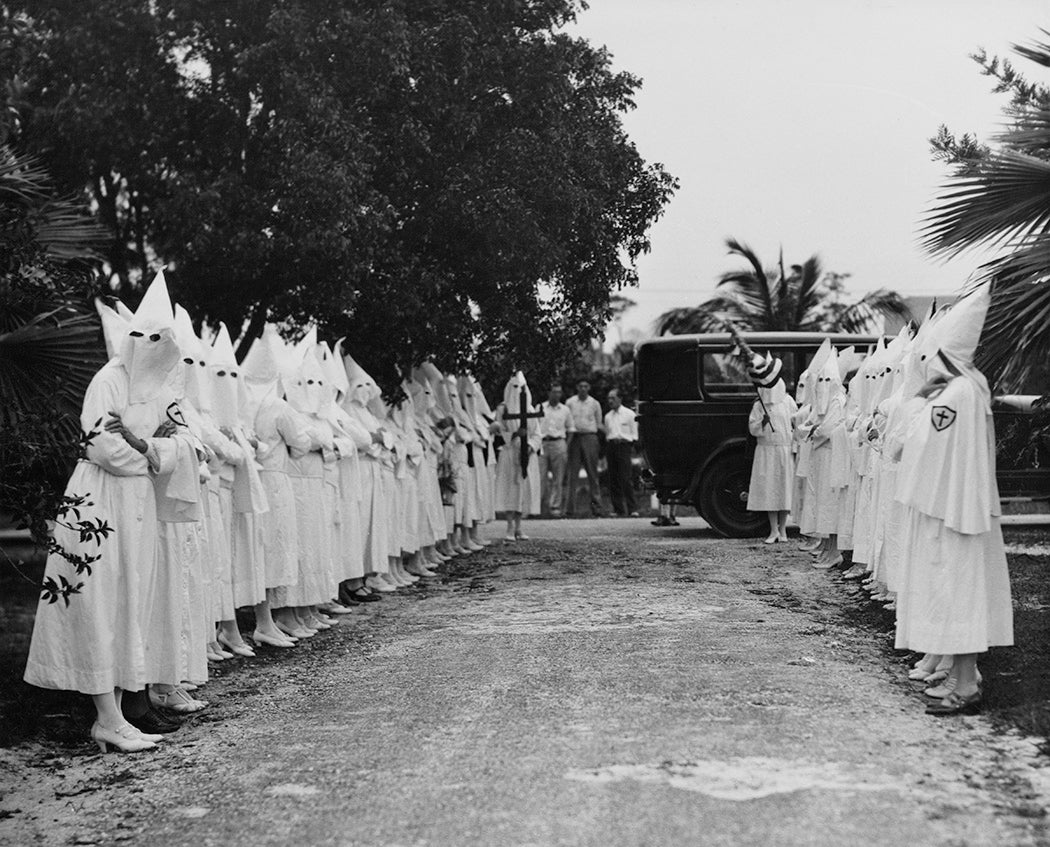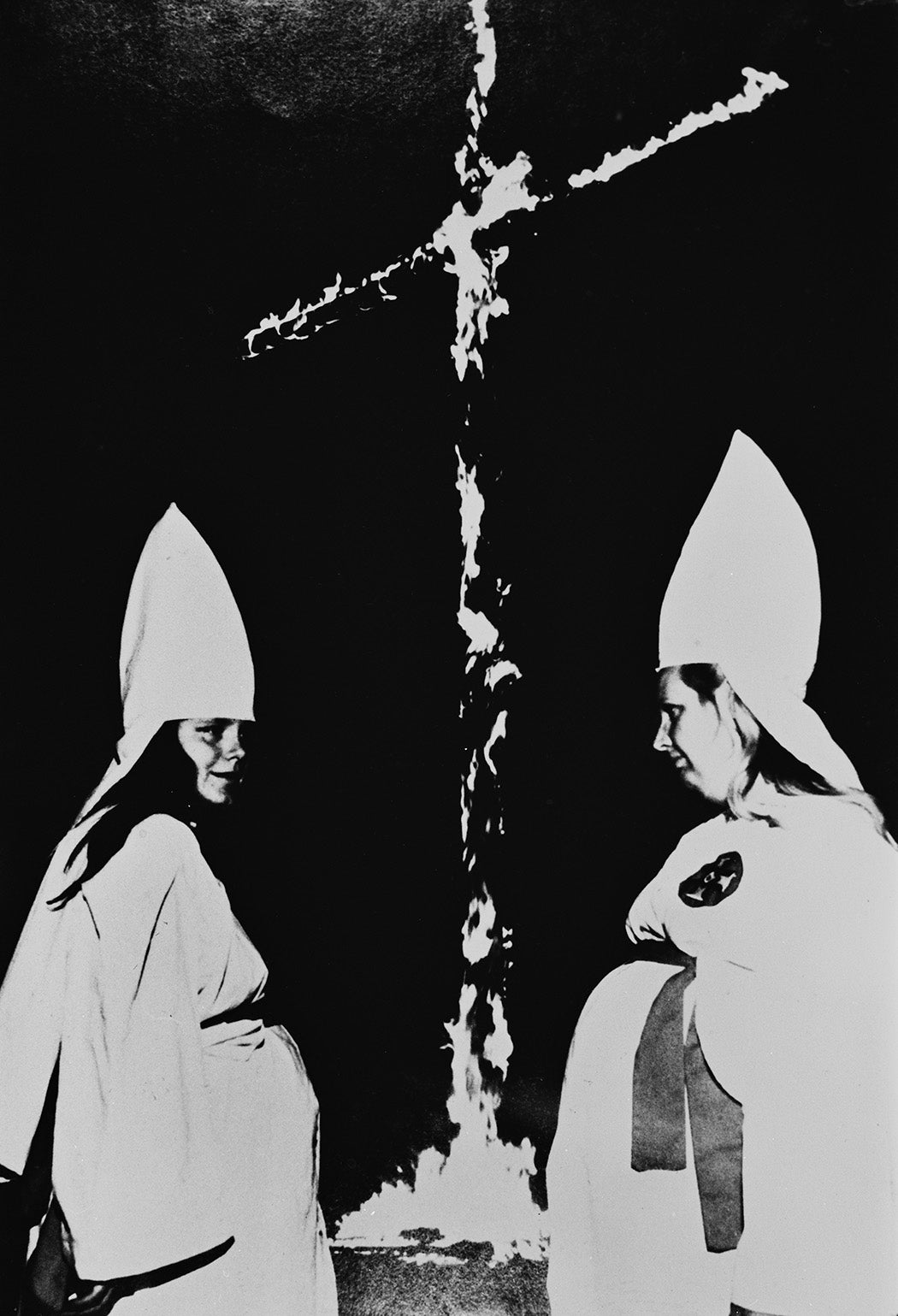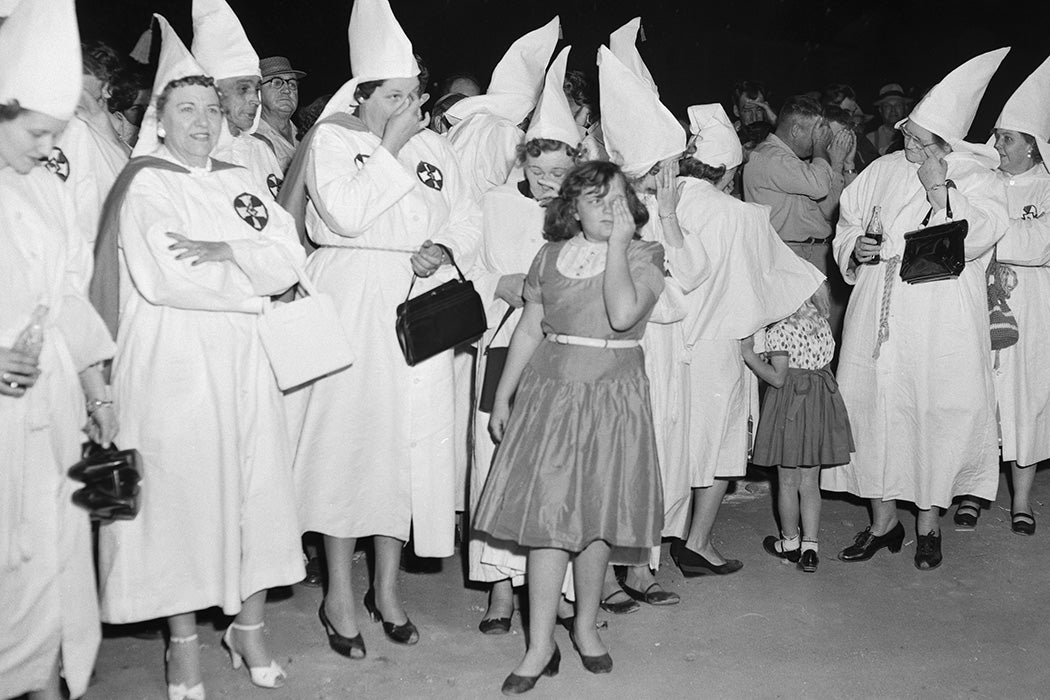In American society, white women are often understood as victims, but we—for I am a white woman—also can be perpetrators. This peculiar dichotomy has exploded into the national consciousness during this summer’s long-overdue reckoning over race. Some white women, while teetering on the ladder of privilege, wield their anger as a weapon against those with less power than them. But this dynamic is not new. One of the most shocking and extreme examples of white female complicity in American racism is an organization called the Women’s Ku Klux Klan.
The first iteration of the KKK sprang up in Pulaski, Tennessee, after the Civil War, formed by men who were disgruntled about newly freed Blacks, resentful about enfranchisement, and craving meaning, excitement, and a socially sanctioned venue in which to commit acts of violence. Contemporary observers said that these early KKK vigilantes wanted “novelty and mystery and secrecy,” as the attorney general of Mississippi testified in 1871, and they got it, designing elaborate, arcane rituals and rigid hierarchies through which to further their hateful anti-Reconstruction agenda.
Audio brought to you by curio.io
Women did not participate in this iteration of the Klan, except as auxiliaries; some sewed or lent clothes to their husbands and family members to aid in their costumed rituals and racist activities. Women also played a symbolic role in this version of the Klan: one of the stated goals of these terrorists was—as they would have understood it—to shield angelic female innocents from the terrifying Black “demons” who had been unleashed on the countryside. Hstorian William F. Pinar explains:
Particularly during its early years, the male Klan held two contradictory images of femininity and womanhood, one imaginary, and one a concession to the reality of concretely existing people. In their imagination, white Protestant women (femininity applied only to these) were innocent, virtuous creatures whose raison d’être was to support and serve men. In turn, men would protect these vulnerable sexually appealing ladies from those sexually rapacious demons (i.e., black men) who could not help but desire them.
This first Klan collapsed by the 1870s, but the organization had yet to see its heyday. The second Klan began in 1915, following an anti-Semitic lynching of a pencil factory superintendent in Atlanta and a cross burning on Stone Mountain (also in Georgia). This new Klan, which attracted between three and six million Americans throughout the 1920s, differed from its predecessor in key ways: it was in full view of the public and even intertwined with American government; and it spread far beyond the South, sweeping throughout the United States. The rejuvenated KKK targeted Catholics, Jews, Asian-Americans, Mormons, immigrants, socialists, labor radicals, dance hall owners, and more with a heaping dose of the pseudoscience of eugenics.
Weekly Newsletter
“Kleagles,” or paid organizers, would visit an area to figure out who the white Protestants were anxious about, then drum up support for the Klan in that area by sowing fear and hatred of the outgroup—for a joining fee. This is how the Klan managed to spread to areas without a sizeable Black population (when I was growing up, I heard stories from elderly relatives about the Klan marching through my very-white home state of New Hampshire, raging against the Catholic French Canadians).

This second Klan saw the creation of the Women’s KKK, an affiliated but separate organization specifically for white Protestant women. The early history of the WKKK was beset by intra-Klan squabbles: one male Klan leader started the Kamelias, a women’s white supremacy group, to augment his own power, while another allied with a women’s secret society called The Queens of the Golden Mask. The Golden Mask eventually won out and became the WKKK, which received its first official charter in Little Rock, Arkansas, in 1923. At its peak, historian Kathleen M. Blee explains in Feminist Studies, the WKKK had chapters in every state, with special interest in Ohio, Indiana, Pennsylvania, and Arkansas.
Like the male version of the KKK, the WKKK had all the hierarchical (and, ironically, very Roman Catholic) trappings: the Imperial Commander, the Klaliffs, Klokards, Kligrapps, Klabees, and the Klexter/Klarogos, who enforced Klan conduct, initiated new members, collected dues, and planned events. All of these roles and activities were filtered through the lenses of racism, nationalism, xenophobia, and a desire to preserve the family and combat what they perceived as moral decay.
With a few exceptions, such as a 1924 riot in which WKKK members paraded around with clubs, the WKKK did not engage in the lynching and other acts of violence of their male counterparts. This lack of physical violence has led many historical commentators to view WKKK members, and indeed all women involved in racist movements, as shadowy, inconsequential figures lurking behind the male actors.
But in fact, the WKKK was deeply, regrettably powerful. According to Blee, they were “covert manipulators and cultural organizers,” using their social power to further their agendas. Many of these women were already savvy social players: post-WWI Protestant social clubs and organizations were natural feeder groups for the WKKK. These women led “poison squads,” or whisper networks, to destroy the reputations of anti-Klan political candidates by claiming they were Catholic or Jewish. They tried to oust Catholic public school teachers, led boycotts of businesses, and campaigned for pro-Klan candidates. They built social ties by donating milk to school children and food baskets to needy families, and by planning weddings, christenings, funerals, carnivals, lectures, speeches, and parades, complete with floats and lady horseback riders.
By planning ritual and social events, these women wove the Klan, and its values, into the fabric of American social life—indeed, for them, “all the good people belonged to the Klan.” Scholars of the WKKK and the general KKK emphasize that these organizations were frightening precisely because of their easy compatibility with homogenous, small-town America. The WKKK did not appeal to women because it was so novel, but rather because it, and its ideals and rituals, fit quite naturally with white Protestant American life.
Reflections from former WKKK members demonstrate how many of these women viewed their organization as a social club, as a chance for a nice time with friends. At the end of the twentieth century, elderly white Protestant women from Indiana, interviewed by Blee, recalled the Klan as “just a celebration… a way of growing up,” and as “a way to get together and enjoy.” And in the 1980s, when researchers tried to figure out who supported the resurging Klan of the Civil Rights era (an organization without a separate female group, and without the veneer of respectability of the 1920s KKK), pro-Klan female respondents argued that the organization was devoted to charitable activities and that it consisted of good people.
The image of women forming fun social clubs around their shared commitment to xenophobia and racism is troubling, to put it mildly. That some of these women were conservatives through and through at least fits with what we might expect. But what’s shocking and disturbing is the fact that in the course of crusading for white supremacy, some members and chapters of the WKKK also espoused an apparently contradictory commitment to both progressive politics and feminism.
This was partly a recruitment tactic. With white women newly able to vote and enjoying political power for the first time, the WKKK lured in members by positioning itself as a safeguard for those newly won rights. A recruitment ad for the Indiana WKKK showcases this strategy:
Men no longer aspire to exclusive domination in any field of endeavor that is his authorship, and whether she wears the cool, sequestered veil of life in the home or whether she is in the busy walks of business or fashion, woman is now called to put her splendid efforts and abilities behind a movement for 100 percent American women.
But scholars of the WKKK also report that this wasn’t only a recruitment tactic. It seems that some of these women actually saw the WKKK as a vehicle through which to protect and consolidate the rights of white, Protestant women. In order to understand how a commitment to feminism became tangled up with a commitment to racism, it’s instructional to examine the history of women’s participation in other social movements of the late nineteenth and early twentieth centuries. Both the temperance and suffrage movements were shot through with racism and nativism. A New York Times article published around the centennial of the nineteenth Amendment this summer noted how these prejudices poisoned or distorted the views of some white pro-suffrage leaders. These women often espoused equality for women while simultaneously trafficking in toxic rhetoric about, for example, Black rapists.
Kathleen Blee locates in this cocktail of so-called feminism and racism the undercurrent of thought that made the 1920s WKKK possible. She writes that once the suffrage fight was won in 1920 and feminists were no longer united around this common goal, they were free to splinter into subgroups. And some of those subgroups were dedicated to keeping America white. In this darkest, most insincere version of empowerment feminism, the WKKK promised women the chance to assert their newfound political power, to live life outside the confines of the home, and to exercise autonomy—some women even rebelled against their husbands or divorced them to join the WKKK.

Many of the WKKK’s leaders were already active outside the home: Lulu Markwell, the first national head of the WKKK, had worked for women’s suffrage. Daisy Douglas Barr, who led the WKKK in Indiana and seven other states, was an ordained Quaker preacher. Barr was also the first female vice-chair of the Republican state committee, and an active participant in temperance and women’s organizations. Mary Benadum, another WKKK leader in Muncie, was active in clubs, churches, and in an organization called the Business and Professional Women of Indiana, while Lillian Sedwick, another leader, was on the school board in Indianapolis.
Some of these women claimed that the WKKK would protect against sexual harassment and delinquent husbands. They claimed that the Klan was fighting against the so-called reactionary cultures of Jews, Catholics, and Southern Blacks. As Blee and Pinar chronicle, many of these women claimed to believe in feminism and equal pay. Pinar writes about one kleagle who encouraged WKKK mothers to campaign for an eight-hour workday for the job of childcare. This kleagle and others like her claimed that, through the WKKK, white Protestant women could demand more respect and protections for traditional “women’s work.”
Were these commitments sincere? It’s impossible to know the true motivations of historical actors, of course, but Blee—who spent significant time interviewing former WKKK members in their old age—believed that they were. In his article “White Women in the Ku Klux Klan,” published in the journal Counterpoints, William Pinar quotes Blee: “‘Some Klanswomen had a facile ability to fold bitter racial and religious bigotry into progressive politics. One former Klanswoman, for example, insisted that she saw no inconsistency between participation in the 1920s Klan and her support of economic redistribution and feminism.’” Pinar calls this a “very strange mix” of the progressive and reactionary, but says that as far as we can know, these women claimed to see no inconsistency between their racism and their zeal for Social Security benefits and equal pay. Perhaps the WKKK did want to elevate women in society—specifically, women who hailed from their culture, who looked, acted, and thought like them.
Many members of the male KKK were uncomfortable with white women transforming from sweet, maternal, angelic beings who needed protection into actual actors with agency, while some enemies of the WKKK trafficked in anti-feminist rhetoric when criticizing the organization. One anti-Klan newspaper in Muncie stormed that WKKK members were “bob-haired” and “Amazons,” and that the organization was “a front for women’s adulterous trysts.” But just because the WKKK received criticism from anti-feminist writers does not make its members worthy of respect. A woman taking action and facing criticism for it does not automatically get to claim the label “feminist.”
The WKKK, along with the 1920s iteration of the male KKK, trickled away by 1930, and later incarnations of the Klan did not boast a specific women’s organization or any commitments to women’s rights. But the story of the WKKK is a stark, sobering reminder of how easily racism can poison even Americans who espouse commitments to movements and policies that are dear to modern leftists and liberals, such as women’s and workers’ rights. As Pinar writes, “An accurate account of white women’s participation in the 1920s Klan movement requires those of us committed to a more just and egalitarian society to acknowledge the apparent ease with which racism and bigotry appealed and still appeal to mainstream American citizens.” Especially during this centennial year celebrating an amendment that truly only benefitted white women, feminists must examine the toxic threads baked into the history of our movement. We also must examine and evaluate who, exactly, gets to lay claim to the label of feminist in today’s world. After all, just because a woman is doing something and holding an opinion doesn’t make her worthy of our approval or acclaim.







